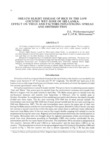Sri Lanka, a tropical island, is agro-ecologically divided into several regions. The low country wet zone comprises land up to 300m above mean sea level with a mean annual rainfall of 2500mm-5000mm.
Sheath blight disease caused by Rhizoctontia solani Kuhn., is considered to be the most prevalent disease of rice in this region. Grain and leaf spotting, sheath rot and to a lesser extent leaf and neck blast are the other diseases of rice observed.
Research investigations have revealed that sheath blight causes yield losses. The factors that predispose the rice crop to this disease are high seed rate and high nitrogen with low potash inputs. Fungicides Pencycuron and Tri-phenyl-tin-hydroxide have effectively reduced sheath blight infection. Screening for disease resistance has not yielded a single resistant line.
Field reports indicate a marked increase in sheath blight infection over the last five years. However yield losses have not been substantial. Chemical methods of control have been used to a limited extent while cultural practices are favored by farmers.

